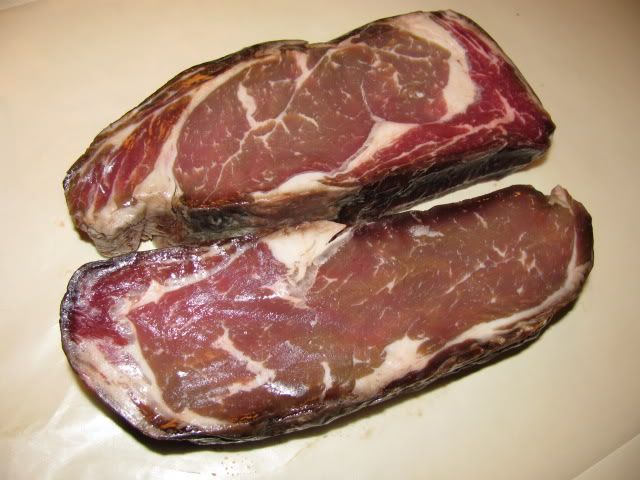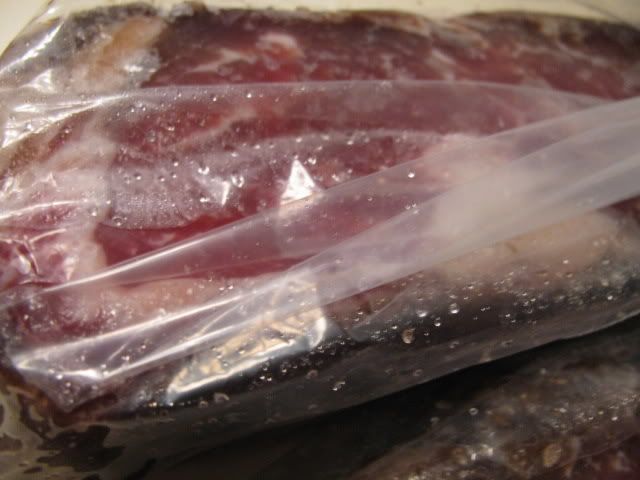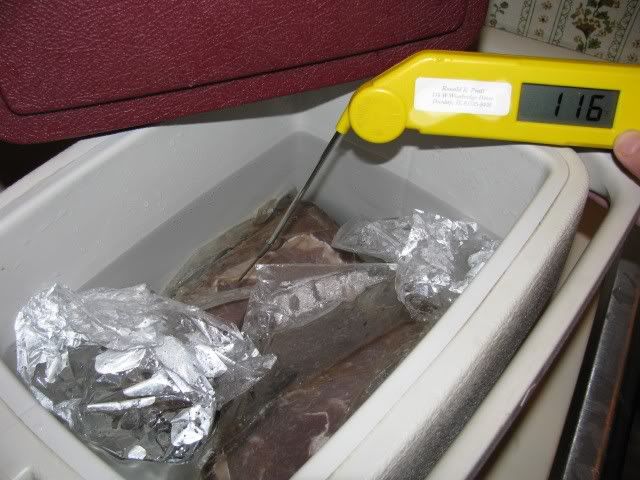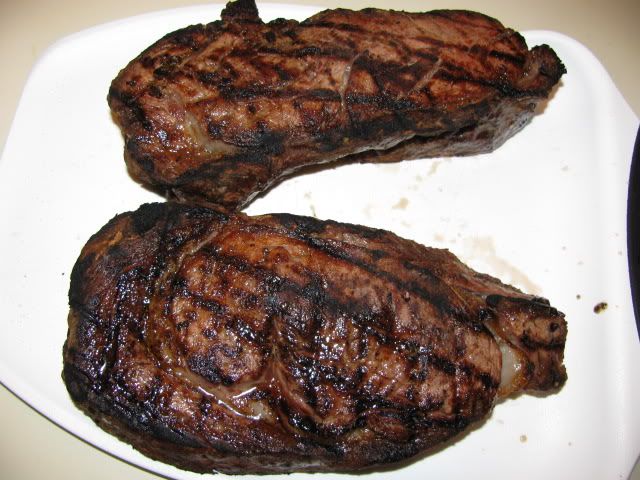The Original Dry Bag Steak | Make Artisan Dry Age Steak at Home › Forums › Recipes › Other Recipes › Hot tubbing steaks (definition thereof)
- This topic has 59 replies, 4 voices, and was last updated 12 years, 2 months ago by
Anonymous.
-
AuthorPosts
-
August 11, 2010 at 4:53 pm #1128
Ron Pratt
MemberFor at least one hour before you plan to put your steaks on your grill place the individual steaks into new disposable plastic food safe bags and press out the air and seal with a twisty.
Place steaks in a large enough container and fill and completely cover with hot tap water. My tap water runs about 125 degrees.
During the hour change the water as necessary so that it stays at or above 100 degrees. This takes me about 4 refills.
After the hour your meat will have an internal temp suitable for immediate searing, though I do hit with kosher salt first. Sear at 650 or higher for about 2 minutes per side or 132° internal meat temperature and enjoy one delicious hot tubbed steak! Obviously a shorter time for more rare meat. Hot tubbed dry aged steaks definitely take less time than cold non-aged ones.
Personally I wouldn’t do it with steaks any thinner than 1.5″. The benefit of hot tubbing is to warm the cold center vs. the cold reddish blue center common to just hot searing a thick cold steak.
Try the hot tub – I bet it will make a believer out of you! I find this method even works well with a large thick prime rib.
August 12, 2010 at 2:15 pm #3985Anonymous
GuestAnother great way to cook a thick steak is to put them in a 250 degree oven for 25 min. I place the steaks on a wire rack over a cookie sheet. Then sear them for 1.5 to 2 min on each side. I learned this technique form cooks illustrated and it works great. It gives you that nice sear on the ends and a consistent warm red center throughout.
August 14, 2010 at 5:18 pm #3988Anonymous
GuestDoes the oven method work good for 1 inch thick steaks?
Also, why wouldn’t the hot tub method work fine for thinner steaks? It seems like it would just take less time to warm up the interior in the hot tub.
August 14, 2010 at 7:04 pm #3991Ron Pratt
MemberI didn’t mean to mislead you about steaks thinner than 1.5″ – what I really meant was twofold. 1) thicker steaks really benefit from hot tubbing by getting the centers warm unlike the cold reddish blue core common to seared steaks. 2) when hot tubbing thinner steaks just sear for a shorter time as they will be quite warm before even putting them on and they will overcook quickly. Personally I think steaks cooked more than medium rare at most is a waste of beef. In other words I wouldn’t even bother hot tubbing a thin steak if your intent was to serve it medium to well done.
August 16, 2010 at 1:17 pm #3999Anonymous
GuestIt’s hard to cook a thick steak medium rare because by the time the internal temperature reaches 125-130 degrees, the peripheral meat is scorched. By preheating the meat in a hot tub or oven, less heat is required to raise the internal temperature which leads to less over cooking. Thin steaks don’t require a lot of time to raise the internal temperature therefore they can safely be cooked over direct heat.
October 11, 2010 at 3:19 am #4067Anonymous
GuestYou have to be careful with meat < 130 degrees when oxygen is depleted. Botulism is the primary threat and that environment is ideal for it's growth. For more info dig up Sous Vide cooking. As s side note, I love cooking this way! Perfect medium rare all the time. It's just time consuming!
October 11, 2010 at 3:57 pm #4068Ron Pratt
MemberI believe the USDA warning is unfrozen meat held in a warm bacteria nurturing environment below 140° for more than 4 hours is at risk – but certainly not the1 hour that I hot tub.
November 9, 2010 at 11:48 pm #4174Ron Pratt
MemberThis Saturday night I’m going to try yet another tweak to further enjoy my dry aged steaks. Based on data from the magazine Cook’s Illustrated I intend to lightly coat my meat with salt for 3 hours and bagging them prior to the additional hour in the “hot tub”. According to CI…,“The salt draws juices to the surface of the meat. The juices became a concentrated brine that is reabsorbed into the meat, bringing out beefy flavors and masking livery ones.”
Furthermore I intend to use Morton canning salt as it is finer and should dissolve far easier since the dry aged meat already has had about 20% reduction in moisture so my thinking is the canning salt will have a better chance of working. I will report my finding on Sunday.
November 13, 2010 at 3:20 pm #4178Anonymous
Guestso how did the salting procedure work? fwiw, i attended a cooking class recently (Dean Fearing , Dallas) and they use fine sea salt on everything instead of the course sea salt. says it’s almost impossible to over-salt. I’m sure if you intentionally oversalted, that wouldn’t hold true..
November 13, 2010 at 4:48 pm #4179Ron Pratt
MemberThat’s what I doing tonight and will post my results on Sunday. BTW here’s a handy site to give you the lowdown on types of salt and other info.
mortonsalt.com/salt_guide/index.htmlI noticed that the canning salt I intend to use is identical in properties to the fine sea salt you mentioned, except canning salt is additive free.
November 14, 2010 at 7:16 pm #4185Ron Pratt
MemberRRP wrote:
quote :This Saturday night I’m going to try yet another tweak to further enjoy my dry aged steaks. Based on data from the magazine Cook’s Illustrated I intend to lightly coat my meat with salt for 3 hours and bagging them prior to the additional hour in the “hot tub”. According to CI…,“The salt draws juices to the surface of the meat. The juices became a concentrated brine that is reabsorbed into the meat, bringing out beefy flavors and masking livery ones.”Furthermore I intend to use Morton canning salt as it is finer and should dissolve far easier since the dry aged meat already has had about 20% reduction in moisture so my thinking is the canning salt will have a better chance of working. I will report my finding on Sunday.
Here’s the two rib eyes weighting in at 17 oz. each that I had dry aged for 28 days a little over a year ago and had then frozen them using a Food Saver. As you can see these were very dry on the surface.

I then proceeded to dust them using Morton canning salt which is extremely fine almost like cornstarch. What surprised me was as soon as the salt landed on the meat the steaks started to glisten and there was no white coating at all! I dusted the sides, edges and ends and then placed each steak into a plastic bag, squeezed out the air and sealed with a twisty. At that point I returned them to the refrig for the 3 hour period.
Half way through at 90 minutes I examined the steaks and as promised they were wet and had beads of moisture galore, which you should be able to see.

After the 3 hours I began the hour long hot tub and noticed that also as predicted the moisture was mostly gone from being drawn back into the meat. This time I used a small Coleman “6-pack” chest and found that by using it complete with the lid I only needed to change the water once during the whole hour vs. my normal 4 times. Note even at the end of the hour the water was still 116°.

Then it was time to go on my BGE direct at 650° for a quick 3 minute sear. It was getting late and I would have preferred to get my temp up to more like 700 to 725, but so be it. For some unknown reason before I started the sear I hit the steaks well like I always do with some coarse kosher salt – something I regret now!
In short order it was show time and there was that look from the better half as if to ask “are we going to eat those or are you taking more pictures?” So this was my last picture!

Results were a too salty, but I really blame the kosher I needlessly added before the cook. I’ll definitely try the 3 hour salt method again. BTW those 28 day steaks were fork tender and oh so delicious! VIVA DrybagSteak!
November 14, 2010 at 7:31 pm #4186Anonymous
Guestthanks for the update. I’ll try that with some wet aged steaks, next week. while waiting for the dry aging of my NY strip…
November 27, 2010 at 10:32 pm #4234Anonymous
GuestGonna try out a small variation of the pre-salting tonight with $S salt from Penzeys. Kinda like a lawreys salt. This is with wet aged as i’m only on day 14 with my NYS. update after dinner!
November 28, 2010 at 2:14 am #4235Ron Pratt
MemberYes, please let us know! I had scratched my head for a while wondering what you meant by Penzeys $S salt and then it dawned on me the $ sign is the upper case for the 4 key! Now I’m on the same page with you as I have wondered, but just never ordered Penzeys 4/S salt. My wife is a salt nut and we have also found a tasty one offered by Mrs.dogs called Chipotle Salt. Can’t tell you how many brands and types of salt we have in our pantry!
November 30, 2010 at 9:06 pm #4238Anonymous
Guestyeah, my typing/proofreading schools are pretty bad.
Anyway, this experiment will have to go through a do-over as i managed to blow it on temp control. way too rare. i shoot for med/rare and a refire doesn’t come out the same. the meat ended up not being very tender. I think it held promise as the outside did seem to have an improved taste/texture. my dry aged will be at 21 days and i’ve run out of patience, so this weekend will be dry aged.
-
AuthorPosts
- The forum ‘Other Recipes’ is closed to new topics and replies.
